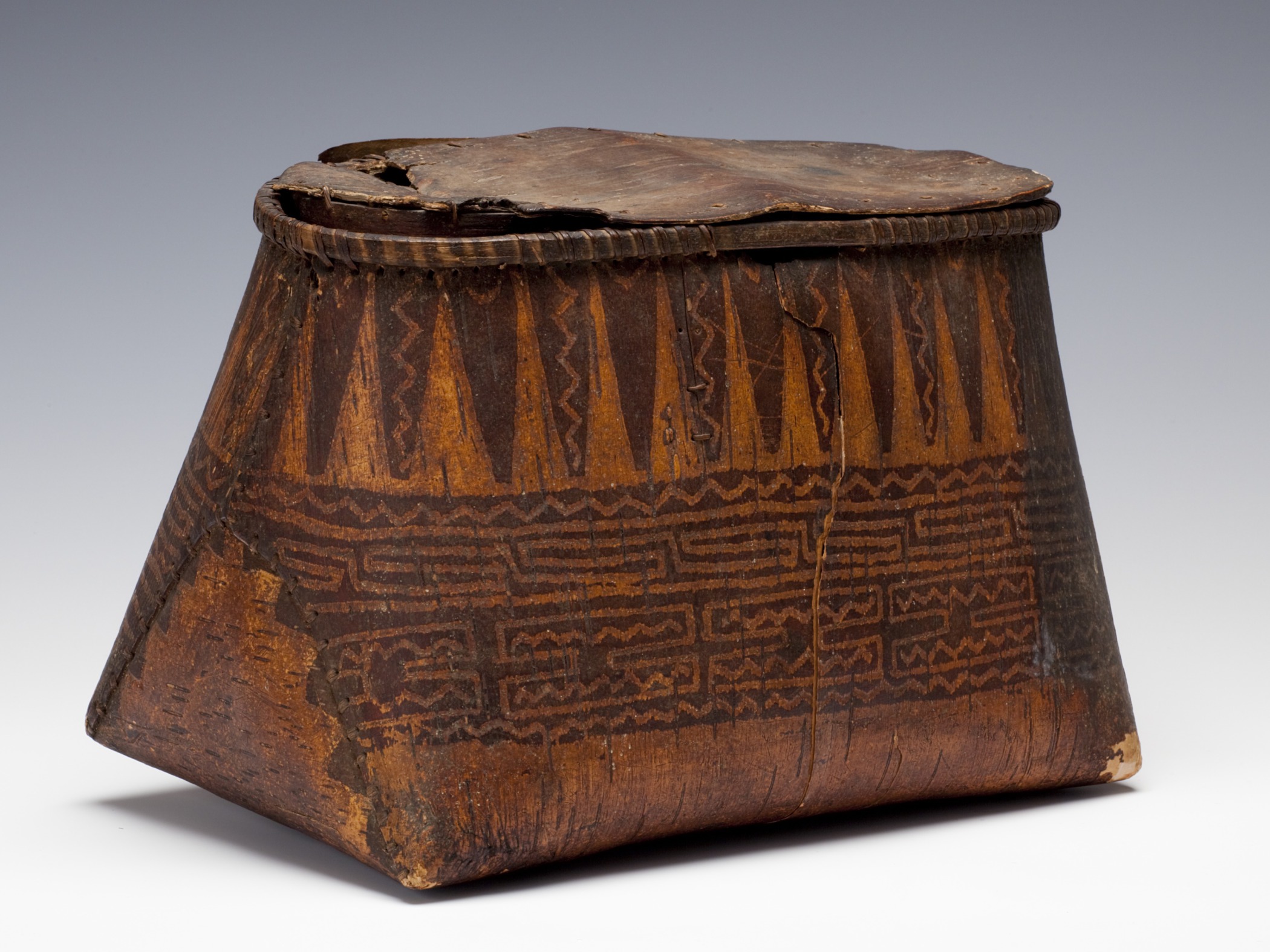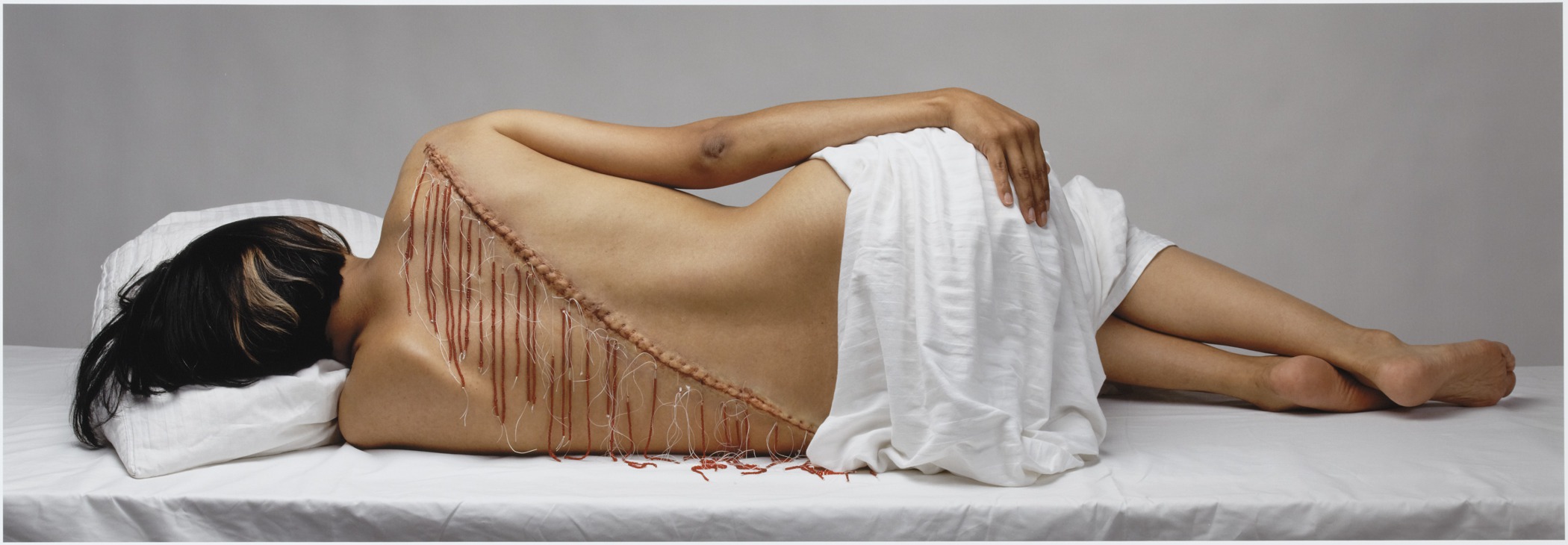Unknown people (Woodlands)
Container depicting the cosmological universe and, on the underside, two thunderbirds
- About 1800
- Birch bark, wood, spruce root, twine (added later)
- 8 11/16 × 8 1/4 × 6 1/8 in.
Hood Museum of Art, Dartmouth College: Museum Purchase; 163.66.15194
visibilityLook & DiscussThis rare container carries on its surface a representation of the cosmos, or picture of the universe organized into an ordered whole. Although an Anishinaabe artist created this box 200 years ago, the powerful symbols are older and trace back to the ancestors of the Woodlands and Plains cultures.
Explore the object
The designs on this birch bark box represent the two realms of the Woodlands cosmos: the Above World and the Underwater World.
The row of vertical triangles circling around the upper edges of the box represent the Above World. This part of the design has a light background.
The triangles represent the life-giving rays of the sun.
Each triangle may also represent a stylized feather and symbolize the Thunderbird, a supernatural being who rules over the Above World. Every second triangle has a zigzag line indicating the lightning bolt the Thunderbird shoots from its eyes and flapping wings.
By contrast, the lower half of the box represents the Underwater World. It has a dark background. The long zigzag line circling the container represents waves, and the dense patterns below suggest the mysteries of this realm. The Underwater Panther rules this world and causes waves and whirlpools by whipping its powerful, long tail around in the water.
The bottom of the container has two thunderbirds incised or cut into the surface of the birch bark. To make the designs, the artist cut into the surface of the dark inner bark of the birch tree to reveal the lighter color underneath. Both thunderbirds have heartlines, a single triangle or v-shape on their chests. The artist applied ochre, a reddish pigment, to the surface after drawing the thunderbirds. The color red signifies health, vitality, and wellbeing.
The body of the box is made of one piece of birch bark folded and sewn together with spruce root. The bottom of the box is a rectangle, while the sides have been folded over so they taper toward the top and create an oval.
Birch bark contains a natural preservative that resists spoiling and fungus growth. This box may once have been a container for food, medicines, or ceremonial items.
Activity: Birch Bark Play
Birch bark was an important resource to the people of the Eastern Woodlands. They used it in the construction of their homes, as the shells of their canoes, and for articles of clothing. They shaped and sewed it into a variety of dishes and food preparation tools, storage containers, and ceremonial items.
Preparation
Collect birch bark in the forest. Be sure to only collect bark from fallen trees or bark that has fallen to the ground. Removing birch bark from a live tree will kill it.
Wash and dry the pieces.
Drawing
Using a pointed stick or a sharp stone, try incising or cutting images or patterns into the surface of the dark inner bark. See if you can create an image without tearing the entire piece. Lightly oil the surface to bring out the contrast in tones between the dark and light bark and to preserve your drawing.
Containers
Try folding larger pieces of bark into containers. Soaking the bark in hot water will make it more pliable. You can roll strips into cones or cut slits into the corners of a square piece and fold up the sides to create a small box. Use staples or a needle and thread to secure the sides.
Woodland artists generally used the inner bark on the outside of their containers, but you can use the inner or outer bark as you like. Again, lightly oiling the container will help preserve the birch bark and bring out the colors in the bark.
Note on Best Practices
This activity is designed to help students learn more about resources in the natural world and to learn from Native American ingenuity. It is important to say that you are making birch bark containers, not “Anishinaabe” or “Native American containers.” Only Native American artists can make Native American art.
Learn More
Louise Erdrich’s novel The Birchbark House is filled with information on traditional Anishinaabe lifeways, including many native uses of birch bark.





